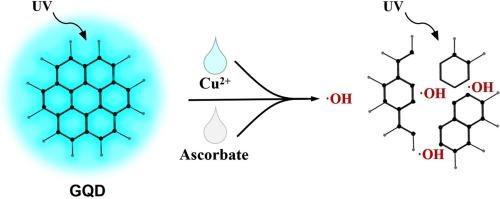基于石墨烯量子点的铜离子荧光和可视化双模式检测。
IF 4.3
2区 化学
Q1 SPECTROSCOPY
Spectrochimica Acta Part A: Molecular and Biomolecular Spectroscopy
Pub Date : 2024-11-17
DOI:10.1016/j.saa.2024.125442
引用次数: 0
摘要
在本研究中,我们利用石墨烯量子点(GQDs)和 Cu2+ 离子催化的 Fenton 类反应的协同特性,提出了一种 Cu2+ 离子的荧光和可视化双模式检测方法。Cu2+ 离子和抗坏血酸的 Fenton 类反应会产生高活性羟基自由基(-OH),从而有效破坏 GQDs 的结构,导致荧光淬灭。在优化条件下,荧光淬灭度在 40 到 2000 nM 范围内与 Cu2+ 浓度呈线性相关,从而实现了对低至 40 nM 的 Cu2+ 离子的检测。此外,我们还证明了利用便携式紫外仪器对水中 Cu2+ 离子浓度进行半定量视觉检测的可行性。该方法实现了低至 10 μM 的 Cu2+ 离子最低可检测浓度,超过了美国环保局设定的 20.47 μM 的最大污染物水平目标和世界卫生组织推荐的 31.47 μM 的指导值。因此,这种方法有望成为在铜污染紧急事件期间检测水中 Cu2+ 离子的护理点检测 (POCT) 方法。此外,这种方法还可用于检测抗坏血酸。我们的研究结果展示了这种双模式检测方法的潜力,它提供了一种灵敏、快速、高效的 Cu2+ 离子检测方法,从而有助于环境监测和公共卫生应用。本文章由计算机程序翻译,如有差异,请以英文原文为准。

A graphene quantum dots based dual-modal fluorometric and visualized detection of copper ions
In this study, we present a dual-modal fluorometric and visualized detection method for Cu2+ ion, leveraging the synergistic properties of graphene quantum dots (GQDs) and Cu2+ ion catalyzed Fenton-like reaction. The Fenton-like reaction of Cu2+ ions and ascorbate generates highly reactive hydroxyl radical (·OH), which effectively disrupt the structure of GQDs, leading to fluorescence quenching. Under optimized conditions, the fluorescence quenching degree exhibited a linear correlation with Cu2+ concentration within the range of 40 to 2000 nM, enabling the detection of Cu2+ ions as low as 40 nM. Furthermore, we demonstrated the feasibility of semi-quantitative visual detection of Cu2+ ion concentrations in water using a portable ultraviolet instrument. The method achieved a minimum detectable concentration of Cu2+ ion as low as 10 μM, surpassing the maximum contaminant level goals of 20.47 μM set by the EPA and the guideline value of 31.47 μM recommended by the WHO. As such, this approach holds promise as a point-of-care testing (POCT) method for Cu2+ ion detection during copper pollution emergency events in water. Additionally, this method can be adapted for the detection of ascorbic acid. Our findings showcase the potential of this dual-modal detection approach, offering a sensitive, rapid, and efficient means for detecting Cu2+ ion, thereby contributing to environmental monitoring and public health applications.
求助全文
通过发布文献求助,成功后即可免费获取论文全文。
去求助
来源期刊
CiteScore
8.40
自引率
11.40%
发文量
1364
审稿时长
40 days
期刊介绍:
Spectrochimica Acta, Part A: Molecular and Biomolecular Spectroscopy (SAA) is an interdisciplinary journal which spans from basic to applied aspects of optical spectroscopy in chemistry, medicine, biology, and materials science.
The journal publishes original scientific papers that feature high-quality spectroscopic data and analysis. From the broad range of optical spectroscopies, the emphasis is on electronic, vibrational or rotational spectra of molecules, rather than on spectroscopy based on magnetic moments.
Criteria for publication in SAA are novelty, uniqueness, and outstanding quality. Routine applications of spectroscopic techniques and computational methods are not appropriate.
Topics of particular interest of Spectrochimica Acta Part A include, but are not limited to:
Spectroscopy and dynamics of bioanalytical, biomedical, environmental, and atmospheric sciences,
Novel experimental techniques or instrumentation for molecular spectroscopy,
Novel theoretical and computational methods,
Novel applications in photochemistry and photobiology,
Novel interpretational approaches as well as advances in data analysis based on electronic or vibrational spectroscopy.

 求助内容:
求助内容: 应助结果提醒方式:
应助结果提醒方式:


